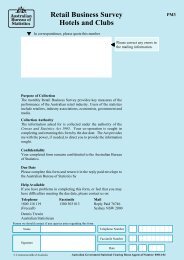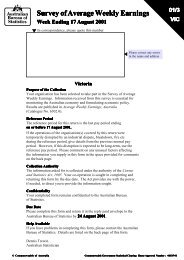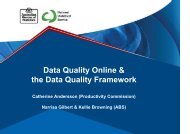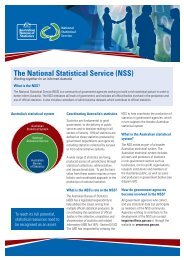SAE Manual Sections 1 to 4_1 (May 06).pdf - National Statistical ...
SAE Manual Sections 1 to 4_1 (May 06).pdf - National Statistical ...
SAE Manual Sections 1 to 4_1 (May 06).pdf - National Statistical ...
Create successful ePaper yourself
Turn your PDF publications into a flip-book with our unique Google optimized e-Paper software.
A Guide <strong>to</strong> Small Area Estimation - Version 1.1 05/05/20<strong>06</strong><br />
ultimately hinge upon user decision making requirements. It makes sense <strong>to</strong> choose<br />
small area that are as close as possible <strong>to</strong> the areas used for program planning and<br />
implementation. However, such areas are often really no more than administrative<br />
regions, chosen for pragmatic or logistical reasons such as transport costs or workforce<br />
management efficiency. <strong>Statistical</strong> units within these administrative regions are not<br />
necessarily homogenous with respect <strong>to</strong> the variable we are trying <strong>to</strong> calculate small area<br />
estimates for. If this is the case it may be worth considering (subject <strong>to</strong> the minimum<br />
sample size requirement) small areas at a finer level with greater homogeneity <strong>to</strong> obtain<br />
a better fitting model. Small area estimates at this level can then be aggregated <strong>to</strong> the<br />
required administrative regional level.<br />
For example, in the disability empirical study, disability programs are funded and<br />
administered at the level of Disability and Health Services Regions (DHSR) which are<br />
aggregations of usually a few LGAs. LGA was considered sufficiently close for modelling<br />
purposes while also having the advantage of sufficient sample sizes and higher level of<br />
homogeneity with respect <strong>to</strong> disability characteristics.<br />
Another example is that of producing small area estimates of water usage. One might<br />
consider using water catchment areas because that is the level required by users,<br />
however these are not always standardised across water and energy authorities. There is<br />
also the problem of geocoding ASGC classifications on which ABS data is based <strong>to</strong> the<br />
water catchment area. Water catchment areas can also be vast along major river systems,<br />
encompassing very different land uses, rainfall patterns and geological drainage features.<br />
3.4 Variable of Interest<br />
The variable of interest is typically measured from an ABS sample survey. This forms our<br />
dependent variable <strong>to</strong> build the small area model around. If the proportion of the<br />
population with a characteristic of interest is constant across broad geographic areas<br />
(e.g. assuming each small area has say, the same rate of heart attacks within NSWs), then<br />
auxiliary data are not really needed and a simple technique such as the broad area ratio<br />
estima<strong>to</strong>r will give good results.<br />
In practice, however, this will be a strong assumption <strong>to</strong> make. If we believe that small<br />
area proportions vary with other fac<strong>to</strong>rs then auxiliary information will be required <strong>to</strong><br />
build a model. The auxiliary data can help explain the variation between small areas and<br />
assist in creating quality small area estimates.<br />
Another point for consideration is that in many applications there will be not just one<br />
but a number of variables of interest requiring small area estimates. Auxiliary data may<br />
not be available for each of these and the strength of the relationship between each<br />
variable of interest and the available auxiliary variables may vary markedly. Prioritising<br />
the variables of interest with users will assist in focusing effort <strong>to</strong> improve the quality of<br />
those estimates that matter most.<br />
3.5 Quality of Auxiliary Data<br />
Potential auxiliary data should be evaluated for their relationship <strong>to</strong> the variable(s) of<br />
interest, both theoretically and statistically as well as the accuracy and reliability with<br />
which they have been collected. The theoretical relationship should emanate from<br />
tested social or economic theories. A careful examination should be made <strong>to</strong> understand<br />
Australian Bureau of Statistics 22








